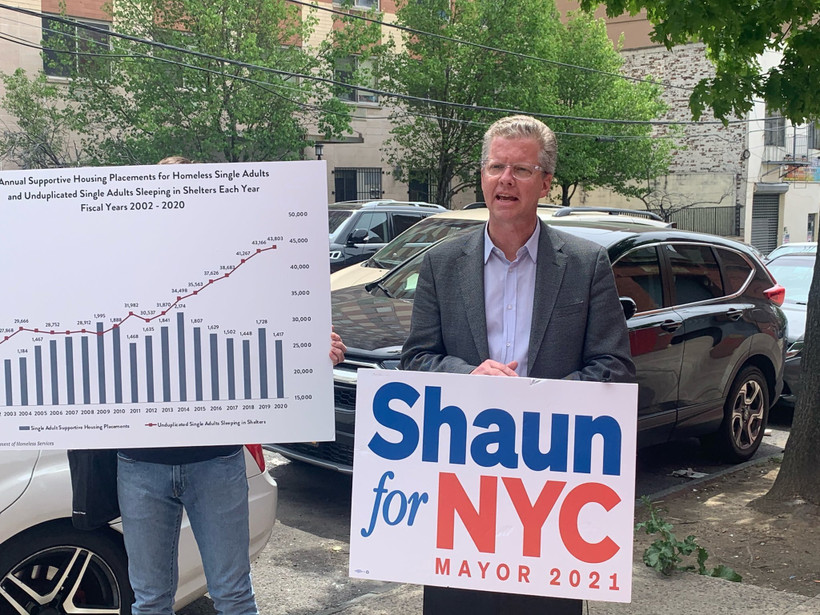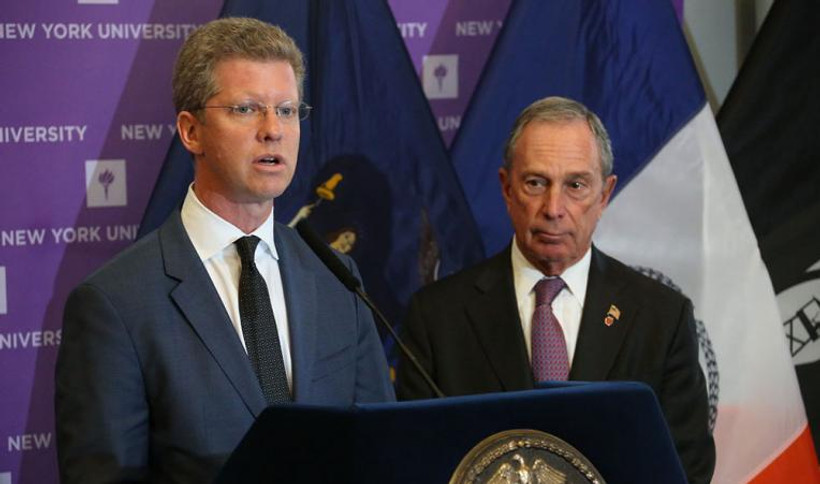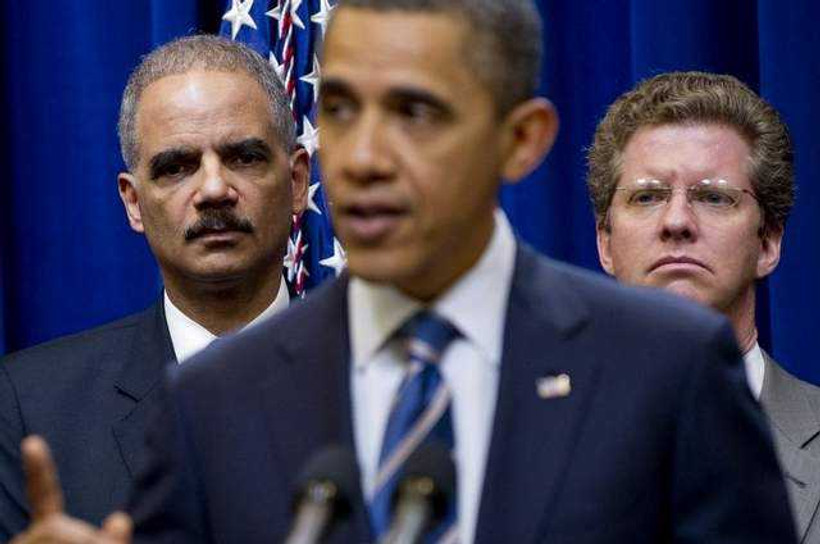What Shaun Donovan’s Record Reveals about His Approach to Housing Crises
Donovan has a progressive housing platform. But does it match his record?

This article is published in our Perspectives section, featuring analyses and views by New Yorkers uniquely qualified to weigh in on high-stakes political debates. Views expressed may not reflect those of New York Focus.
This article is published in our Perspectives section, featuring analyses and views by New Yorkers uniquely qualified to weigh in on high-stakes political debates. Views expressed may not reflect those of New York Focus.
In 2016, Shaun’s Donovan’s record looked so sterling that Bradley Tusk—the political fixer, venture capitalist, now the man behind Andrew Yang’s campaign—tried recruiting him to challenge Tusk’s nemesis, Bill de Blasio, in the Democratic primary for mayor of New York City. Donovan passed and remained in his role as President Obama’s budget director.
This time around, Donovan has arguably the most impressive resume of all the mayoral candidates—especially when it comes to housing, which is second only to crime and policing as the race’s top issue. Donovan served under mayor Michael Bloomberg as Commissioner of Housing Preservation and Development (HPD), then for the entirety of Barack Obama’s presidency as the Secretary of Housing and Urban Development (HUD) and then the Director of OMB.
His housing platform is among the most progressive in the race, including historic commitments of $2 billion per year in city capital funds for public housing and another $2 billion for HPD to finance over 30,000 units of affordable housing per year. Donovan even told me that he would support the good cause eviction bill in the state legislature, which would protect tenants from evictions after prohibitively expensive rent hikes.
And his candidacy is well funded, thanks to a $6.8 million independent expenditure PAC backed by his father.
So why, then, has his campaign failed to break through the second tier of candidates? Some have suggested that it is because he has “no political base to speak of in the city,” but neither did first-tier candidates Andrew Yang or Kathryn Garcia before they announced their candidacy; others, that Donovan’s privilege is off-putting to voters, but that certainly didn’t stop Michael Bloomberg or Andrew Cuomo.
The simplest answer is that voters can see through Donovan’s talking points to the actual substance of his record. For all the sweeping housing development and transformation of the city’s skyline during the Bloomberg era, for most New Yorkers it became an increasingly unaffordable place to live. And in spite of Donovan’s frequent reminders on the campaign trail of having served as Obama’s housing secretary during the financial crisis, in the end, the banking industry was saved at the expense of millions of Americans whose homes were foreclosed as a result of policies designed to subordinate the interests of working Americans to the financial system.
The Bloomberg Era
“As commissioner of the NYC Department of Housing Preservation and Development (HPD),” reads Donovan’s policy platform, “Shaun Donovan crafted and carried out the largest and most ambitious affordable housing plan in the nation. He boosted the housing plan from a 65,000-unit program to 165,000 units and spurred the revitalization of neighborhoods that had long struggled to recover from the blight and abandonment of the 1970s and 1980s.”
Left unmentioned is that these 165,000 affordable units represented gross, as opposed to net, units. In fact, the city during the Bloomberg era lost thousands more units of affordable housing every single year than were being created. According to data from the Furman Center at New York University, from the beginning of Bloomberg’s term until fall 2009, shortly after Donovan had departed HPD for HUD, the administration’s development and preservation of 94,000 units towards its benchmark had been well surpassed by a loss of 200,000 units affordable to low-income tenants, most of which were caused by the deregulation of rent stabilized units.

In Bloomberg’s City Hall, public policy was driven by an effusiveness for a market-driven framework of governance—especially when it came to housing. Jarrett Murphy of City Limits wrote how, as housing commissioner, Donovan “used to argue that any addition to the city’s housing supply—even real high-end stuff—helps to relieve the upward pressure on housing prices for all income levels.” This reflected the Bloomberg administration’s strategy of leveraging City Hall’s tools to spur real estate development, including changes to zoning, tax incentives, and the privatization of public land. In turn, it was thought, the increase of housing supply, even if it was predominantly being developed at the top of the market, would ‘trickle down’ affordability.
Among the most controversial of these subsidies was the 421-a property tax abatement, which began in the 1970s to spur housing development. In 2006, amid pushback against 421-a—it had been costing the city $320 million per year in tax revenues and just eight percent of the 100,000 apartment units financed with 421-a since its inception had been affordable to low and moderate income households—Bloomberg created a task force, headed by Donovan, to revise it.
The administration defended key provisions of 421-a. One of the most contentious provisions was the transferability of 421-a “certificates,” in which instead of building affordable housing themselves, developers could purchase tax credits from developers of affordable apartments in low income areas, often for as low as one fifth of their exemption value. (In one case, one of the buildings at the Trump Place apartment complex received $12 million in tax breaks from certificates that were acquired for just $2 million.) According to the New York Observer, Donovan had “argued that the 421-a certificate program needs to be fixed, not abandoned”—and indeed he fought an alternative bill that would have required all developments receiving the tax break to build affordable units.
In the end, the revised policy curbed the issuance of new certificates but didn’t impede the circulation of existing ones, which is how an ultra-luxury residential skyscraper like One57, completed eight years after the revision, could receive $65.6 million in tax breaks over 10 years. In return, according to the city’s Independent Budget Office, the city received 66 affordable units financed by the $5.9 million the developer spent on 421-a certificates; its full tax liability over those 10 years could have financed 367 new affordable units.
421-a comes up for renewal next year; the next mayor will have enormous influence in whether it is continued. According to recent estimates, the program costs the city $1.7 billion per year in tax revenue, and a 2015 study by the Furman Center argued that it was also bidding up real estate values.
But Donovan’s position on the tax break seems not to have changed much from his Bloomberg days. “I do not believe at this time, where we have a substantial affordable housing crisis compounded by the pandemic, that we should be discarding any tools for affordable housing,” Donovan told me when I asked whether he would renew 421-a. Instead, he argued, “we need to reform it and ensure that we’re getting more bang for the buck, more affordable housing. But I do not believe that we should give up a tool that has the potential to inject substantial funding into affordable housing at a time especially when our capital and expense budgets for the city are going to be deeply challenged.”
Relying on luxury developers to build affordable housing through tax subsidies would in effect be a continuation of the Bloomberg era strategy.
“The traditional equation,” Donovan told the New York Times in 2005, “has been that the stronger the real estate market, the harder it is to provide affordable housing. These programs turn that old equation on its head because the stronger the market, the greater the incentive for developers to use these programs and, therefore, provide affordable housing.”
But the new equation did not balance out. A stronger real estate market meant a commensurate increase in rent at a rate far exceeding New Yorkers’ incomes. From 2002 to 2011, average rents at stabilized and market rate apartments in New York City grew 43% and 56%, respectively, while the nightly homeless shelter population over the course of Bloomberg’s tenure increased by over two thirds.
The Home Affordable Modification Program
Donovan is not running on the record of the Bloomberg administration. The linchpin of his campaign is his experience as housing secretary and then budget director under President Obama, who remains popular among Democrats. “When the housing market collapsed, Barack Obama turned to Shaun Donovan to turn it around. Now, Shaun has a plan to turn New York around,” a recent televised ad boasts.
After a record 2.3 million properties went into foreclosure in 2008, one of the Obama administration’s first major policies was the Home Affordable Modification Program (HAMP), which provided incentives for mortgage servicers to voluntarily modify struggling mortgages. Even by the goals set by the administration to “enable as many as 3 to 4 million homeowners to modify the terms of their mortgages to avoid foreclosure,” HAMP was a failure, achieving less than one million permanentmodifications, according to the Treasury Department, while leaving billions of dollars earmarked by Congress unspent.
As journalist David Dayen argued, HAMP “arguably created more foreclosures than it stopped.” Neil Barofsky, the Inspector General overseeing the government’s bailout of the banking system, wrote in his memoir that this was by design: Treasury Secretary Tim Geithner privately admitted that the purpose of HAMP was to “foam the runway” for the banking system by “stretching out the foreclosures, giving the banks more time to absorb losses while the other parts of the bailouts juiced bank profits that could then fill the capital holes created by housing losses.”

A key reason HAMP was doomed from the start is that it was defanged at the behest of banking industry lobbyists—with support, as was later revealed, from the administration itself—of a potent provision, known as “cramdown,” which would have enabled bankruptcy judges to force down the debt owed on residential mortgages (as they can with other debts). Theoretically, according to the Federal Reserve Bank of Cleveland, just the threat of a judge “cramming” down the value of the debt would have pushed lenders into writing down the principal on mortgages. Instead, handicapping itself from having any meaningful leverage to pressure servicers, the administration relied on the industry’s preference of voluntary modifications, in which HAMP was just an incentive for servicers. Ultimately, the incentives were weaker than the profitability of foreclosure.
The blame doesn’t fall on Donovan, who testified before Congress in support of cramdown (as key administration officials like Timothy Geithner and Larry Summers were acting to sabotage it). Yet, the opposition to cramdown was led in large part by the Mortgage Bankers Association, the industry’s lobbying group, with which Donovan was, and remains, close.
“We led the way on this and we are clearly responsible for defeating this for the third time in the last year,” the Mortgage Bankers Association’s chairman boasted to the American News Project. Its vice chairman at the time, Michael Berman, who became the organization’s chairman the following year, by 2012 had become Donovan’s senior adviser at HUD.
Public-Private Entanglement
When I asked Donovan how his experience in the housing crisis would inform his approach to New York City’s impending housing crisis, he stressed ”the importance of housing counseling and legal assistance for families,” and pointed again to his experience from the Obama administration. “I think that has to be the first priority and it’s absolutely shaped by my experience in the great recession and the mortgage crisis,” he added.
Yet the Obama administration’s program for providing housing counseling and debt relief for homeowners facing foreclosure was essentially run through the mortgage banking industry itself. As Donovan explained in a September 2009 Senate hearing, “working with Treasury and the Homeownership Preservation Foundation, HUD encourages distressed borrowers to contact the Homeowner’s HOPE Hotline…to receive counseling and advice on avoiding foreclosures. The 24 hours a day, seven days a week hotline utilizes many HUD-approved counselors who can also help the homeowner reach and resolve issues with servicers.”
This “HOPE hotline” program that borrowers were directed to call to receive HUD-sponsored counseling or modifications was created by a coalition called the HOPE Now Alliance, which was originally launched by the Bush administration in collaboration with mortgage banking industry, including trade associations such as the Mortgage Bankers Association, the Housing Policy Council, and the Financial Services Roundtable. HOPE Now was headquartered at the Financial Services Roundtable—Wall Street’s primary lobbying apparatus—with which it also filed joint lobbying disclosures. Its executive director had been recruited from the government affairs division of a subprime mortgage lender and servicer. The nonprofit that operated the HOPE hotline that borrowers were directed to call, the “Homeowner Preservation Foundation,” was also a member of HOPE Now. This nonprofit was originally established by a $20 million grant from the now-defunct subprime mortgage subsidiary of General Motors’s financial arm (GMAC) and remains funded to this day by mortgage lenders and servicers.
In short, the entry point for borrowers facing foreclosure to receive HUD-sponsored counseling or apply for mortgage modifications—including HAMP, the administration’s flagship relief program—was operated by the same mortgage industry actors that caused the crisis and would wind up illegally foreclosing on millions of homes.
Continuing this trend of relying on the private sector to manage critical government services on behalf of homeowners was the Distressed Asset Stabilization Program (DASP). When thousands of defaulted FHA-insured mortgages of first-time homeowners piled up on HUD’s books, instead of exercising HUD’s power to renegotiate the mortgages directly, or even sell the loans to community-based nonprofits, Donovan created DASP, which auctioned off the distressed mortgages in HUD’s portfolio to private market bidders—including private equity giants like the Blackstone Group—accelerating the post-crisis trend of institutional Wall Street landlords. DASP’s fire-sales were essentially a wealth transfer to Wall Street that came with little meaningful stipulations to protect homeowners. By 2016, less than ten percent of the mortgages sold through DASP resulted in permanent modifications.
Under Donovan’s tenure, HUD also led the administration’s effort to privatize Fannie Mae and Freddie Mac, the government-sponsored enterprises that guarantee the majority of the country’s mortgages. While this effort ultimately failed to pass in the Senate, an investigation by the New York Times raised eyebrows at the revolving doorbetween the Mortgage Bankers Association (MBA) and HUD. Michael Berman, who as chairman of the MBA had been lobbying the administration on the privatization of Fannie and Freddie, was recruited by Donovan to oversee these efforts at HUD as a senior adviser. Before moving to HUD, Berman recruited David Stevens—the commissioner of the Federal Housing Administration, an agency within HUD which Berman had been lobbying—to be the CEO of the MBA. The announcement of Stevens’s transition came just one month after the Treasury and HUD published a report to Congress endorsing the industry’s plan of winding down Fannie and Freddie. Both continued meeting with federal housing officials after returning to the private sector. Berman and Stevens have contributed $5,100 and $2,500, respectively, to Donovan’s mayoral campaign.
‘A Second Bailout to Banks’
The administration’s inability to stem the tide of foreclosures and the abuse of borrowers peaked with the exposure of the robo-signing scandal, in which it was revealed that thousands of foreclosures per day were being processed fraudulently, as servicers were systematically “robo-signing” foreclosure filings without verification or necessary paperwork. In New York City and its surrounding suburbs, a sample of foreclosures probed by the New York Post found that in 92 percent of cases, “banks and mortgage servicers couldn’t prove they had the right to kick the families out on the street.” In other words, the banks and mortgage servicers were stealing New Yorkers’ homes.

One possible response was a national moratorium on foreclosures, which had the support of then-Senate Majority Leader, Harry Reid, and other Democratic leaders. The administration was against this proposal, aligning itself with the mortgage banking industry’s leading lobbying associations, whose arguments Donovan echoed in an op-ed in the Huffington Post. “A national, blanket moratorium on all foreclosure sales would do far more harm than good,” Donovan wrote.
Another alternative following the robo-signing scandal came from FDIC chair Sheila Bair, who suggested requiring that servicers “make a onetime, blanket offer to seriously delinquent homeowners to write down their principal balance [on their mortgage] to below market value.” This too was eschewed by the administration.
The administration’s response was instead the National Mortgage Settlement, a settlement spearheaded by Donovan between HUD, 49 state attorneys general, the Department of Justice, and the five largest mortgage servicers, including Wells Fargo, Bank of America, Citigroup, JPMorgan Chase, and Ally Financial (formerly GMAC). Dubbed a “second bailout to banks” by Yves Smith, the National Mortgage Settlement required that the servicers pay just $5.8 billion in cash—with an additional $20 billion of dubiously “credited” relief—while effectively giving them a “get out of jail almost free card.”
“Shaun Donovan was the point person for this effort to cause a great forgetting about the illegal stealing of millions of homes through false and manufactured and fabricated documents,” reporter David Dayen, author of a book on the foreclosure crisis, told me. “There was no accountability for any individual as a result of the settlement and banks were really not harmed by the settlement. It was a whitewash of the largest consumer fraud in American history.”
Homeowners received little monetary relief. Just 83,567 received a principal reduction on their mortgages, less than ten percent of the number Donovan had promised. As Dayen reported at the time, “the Secretary of Housing and Urban Development sold the settlement on a promise of helping 1 million homeowners, and the final number missed the cut by over 916,000. That’s incredibly sad, and shows the essential dishonesty Donovan displayed in his PR push back in 2012.”
Like HAMP, the National Mortgage Settlement was conveyed to the public as a relief to borrowers, when in fact the benefit accrued mostly to Wall Street. The administration’s programs, explained Matt Stoller, a former congressional staffer for a member of the House Financial Services Committee during the foreclosure crisis and now the Director of Research at the American Economic Liberties Project, were “framed as helping people in trouble with mortgage payments but were in fact designed to orchestrate mass foreclosures.”
Assessing Value
The Obama legacy is perplexing. While the former president himself remains personally popular among Democrat voters, the 6 million foreclosures during his presidency demonstrate that his policies failed to deliver. Donovan, who’s accuratelybranded himself as a wonkish, top-ranking technocrat in Obama’s inner circle, has been running on the legacy of those policies. Perhaps this is why he hasn’t broken single digits in the polls.
Just how out of touch Donovan can be was on display recently when he was asked by the New York Times editorial board what the median cost of a home in Brooklyn was. Donovan guessed $100,000. The correct number was $900,000.
Donovan emailed the Times editorial board hours later, claiming that actually he was referring to the assessed value of homes—a fraction of a home’s market value that is used for calculating the property taxes owed. It’s hard to pin down what the actual median assessed value of an owner-occupied home in Brooklyn is; New York City’s notoriously complex property tax system assigns different rules and exemptions for different types of residential properties.
Whatever the number is, it’s far from $100,000. In 2019, Donovan and his wife purchased a carriage house in Boerum Hill for $2.3 million—needless to say, well above the median price of a home in Brooklyn. The assessed value of their home for tax year 2021 was just $16,813.
Duncan Bryer was director of policy for state Senator Julia Salazar and now is a graduate student of economics at John Jay College.



